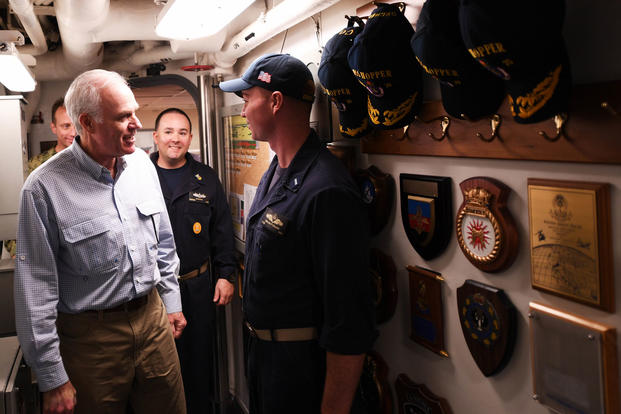In the wake of two deadly ship collisions in the Pacific this summer, the Navy may have to take a hard look at how it's being tasked by top military brass around the world and what it can safely and sustainably accomplish, Navy Secretary Richard V. Spencer said this week.
Speaking to Military.com following the U.S. Naval Institute's annual Defense Forum in Washington, D.C., Spencer said, "I'm not saying the Joint Chiefs simply blindly tasked us, but right now we're fulfilling roughly 50 percent of the tasking.
"And a cathartic event is a reason to stand up and go, 'OK, we really have to rethink this, or at least have the discussion of what the math is behind this so we all understand what we're really dealing with, as far as resources,' " he said.
Global tasking is just one of the facets of Navy operations getting a hard look as the service recovers.
Related content:
- Surge in Wake of Ship Collisions Tests Navy's New Deployment Plan
- Navy: Failures of Leaders, Watchstanders Led to Deadly Ship Collisions
- Why Are Navy Ships Colliding in the Pacific? Experts Weigh In
Spencer told a forum audience that the structuring of fleet forces and personnel management and career paths for officers are among the items receiving scrutiny in his forthcoming strategic readiness review, which called on industry and outside experts to chart a way forward for the Navy.
In early November, the Navy released results of a comprehensive review of operations in the U.S. 7th Fleet and the causes of the two collisions and two other ship mishaps in the region.
In addition to key crew errors, the report found inadequate training and exhaustion, among other things, had contributed to the mishaps.
The 177-page report included some 60 recommendations, but emphasized items such as improvements to training and better evaluation of ship readiness over cutting down on deployments or missions.
"The Navy-Marine Corps team is an organization that is biased for action," Spencer said. "Sitting around and waiting is not something that we enjoy doing. Also, this organization finds it hard to reach into the bag to find the word, 'No, I can't do that.' "
But, he said, sustainability of tempo and tasking had to come into the decision-making process.
"We only have so much capability and so much capacity, primarily capacity, to do the tasks that we can do," he said. " ... We can stretch things, and things are somewhat elastic, but you're going to reach a tension point where that object cannot go back to its original form. And that's what we're dealing with right here."
Military leaders including Spencer are advocating hard against a Continuing Resolution for defense spending, which would freeze spending at current levels and hinder the Navy from planning for the future and making new investments.
Congress is widely expected to pass a short-term CR this week that would extend deadlines to pass a budget by a few more weeks, but the prospect of a long-term CR in lieu of a budget still looms.
But with the funding the Navy needs, planning to expand the fleet, and hard adjustments to structure and operating procedures as a result of the recent reviews, improvements are in sight.
"We have readiness issues in the Navy and the Marine Corps," Spencer said. "We're getting at them, but we have a ways to go. I'm confident we're going to successfully tackle every single issue and right the ship."
-- Hope Hodge Seck can be reached at hope.seck@military.com. Follow her on Twitter at @HopeSeck.












